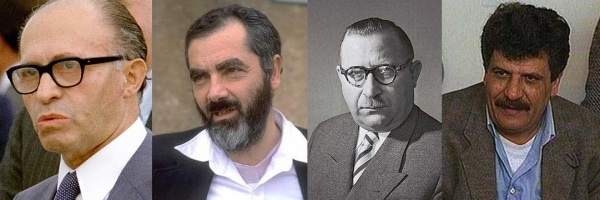The third no-holds-barred column for CNI, Senator James Abourezk tells of his inside experiences with terrorists, alleged terrorists, and the Israel Lobby, including anecdotes about Menachem Begin, George Habash, the Washington Post, the assassin of UN mediator Count Folke Bernadotte, and the Achille Lauro. Senator Abourezk’s first column in his “Tales of the Isreal Lobby” series for CNI was “Firsthand Account: Israeli Plot to Murder Former US Senator?” and his second was “Threats, Dershowitz, & Embedded Lobbyists.”
Alison Weir, President, Council for the National Interest ….
by Senator James Abourezk
Menachem Begin, Meier Kahane, Nathan Yalin-Mor, Abul Abbas
I shudder when Sarah Palin comes on the television accusing President Obama of palling around with terrorists, mostly I fear that she may, someday, catch up with me to disclose to the public my history of palling around with terrorists. To pre-empt Sarah, I will tell everything I know now.
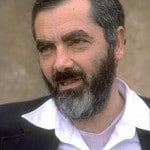
I’ve already written about my experiences with Yasir Arafat. And I once rode down several floors in an elevator in Washington, D.C. with Meir Kahane, a person so frightening that even the Israelis called him a terrorist. I will also admit to hanging out with Khaled Mishaal, the head of Hamas, an accused terrorist who himself hangs out in Damascus, Syria. But what if she finds out that I personally met with the dreaded Jewish terrorist, Menachem Begin, who, during the 1940s was the head of the Irgun, one of the most feared and violent Jewish terrorist groups in the Middle East. Among the many terrorist acts committed by Mr. Begin and his Irgun was the bombing of the King David Hotel in Jerusalem in July of 1946. The bombing killed 91 people of various nationalities, including Brits, and injuring 46 others. And I admit to debating Bibi Netanyahu on Ted Koppel’s Nightline television show back when Bibi was Israel’s Ambassador to the United Nations.
In April of 1948, Mr. Begin and his terrorist thugs joined with another vicious terrorist group called the Stern Gang, massacring some 107 villagers in Deir Yasin, Palestine, including women and children. Many were shot and the rest were killed or wounded when the Jewish terrorists tossed hand grenades into their homes. Several of the villagers were taken prisoner and were most likely killed, but only after they were paraded through the streets of Jerusalem in an action designed to create enough fear among the Palestinians to cause them to leave Palestine.
According to Wikipedia,[1] the most radical Zionist terrorist group was the Stern Gang, or Lehi. Lehi assassinated Lord Moyne, British Minister Resident in the Middle East, and made many other attacks on the British in Palestine. It was described as a terrorist organization by the British authorities.[6] Lehi assassinated United Nations mediator Folke Bernadotte and was banned by the Israeli government.[7] The United Nations Security Council called the assassins “a criminal group of terrorists,”[8] and Lehi was similarly condemned by Bernadotte’s replacement as mediator, Ralph Bunche.[9] Lehi and Irgun were jointly responsible for the massacre in Deir Yassin.
Israel granted a general amnesty to Lehi members on 14 February 1949. In 1980, Israel instituted a military decoration, the Lehi ribbon.[10] Former Lehi leader Yitzhak Shamir became Prime Minister of Israel in 1983.
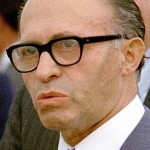
My first and only time palling around with Menachem Begin was shortly after he was elected Prime Minister of Israel in 1977. He came, of course, to Washington, D.C. to begin his victory lap. Washington is where Israel gets its spare money, so why not? The Senate decided to invite him to speak to a Senators only meeting, which is probably the only reason I was invited. I promised myself that I wouldn’t upset his potentially joyful experience in front of those who would be voting to send American taxpayers’ money to Israel, and I kept that promise for quite a while that morning.
I listened as one Senator after another served up to Begin sickening puffball questions, hoping to curry favor with the one person who could tell the Israeli Lobby whom to support and whom to oppose. After all, Begin was the founder of the Likud Party in Israel, and it is no secret that AIPAC, which is the engine that keeps the entire Israel Lobby spinning, was, and is, heavily laden with Likud sympathizers. After hearing one Senator ask Begin the question, “Mr. Prime Minister, do you think the Arabs really want peace?” I could sit in silence no longer. I rose, held up my hand to get recognition, identified myself and asked as follows: “Mr. Prime Minister, I heard your interview on the radio earlier this morning, in which you said you wanted peace, but that you refused to talk to the PLO. How can you say you want peace when you refuse to talk to your enemy?”
Begin, a seasoned debater in the Israeli Knesset, raised his forefinger in the air, and asked, “WHO . . . is the PLO?”
Before he could give his own definition, I interrupted him and said, “The PLO represents the Palestinian people, and it is at least as legitimate as the Irgun was when you were its leader.”
“Sacrilege!” he shouted. “It is a sacrilege to compare the PLO to the Irgun. The PLO kills children; joyfully, willingly. We were different. We were fighting for our freedom.” Just then he must have remembered that others in the room may have read some of the Middle East history as well, so he quickly added in a quieter voice, “Of course, we sometimes made mistakes, and if an innocent person was killed accidently, we always apologized.”
Begin, I’m convinced, was stunned by this show of defiance. Senator Alan Cranston, who was chairing the meeting, immediately adjourned, telling us that it was over with and that we should leave.
As we were filing out of the room, I overheard Senator John Glenn of Ohio telling someone, “Abourezk could start a riot in an empty hall.”
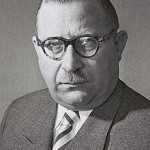
Aside from a few Palestinian terrorists I’ve broken bread with, I knew another Jewish terrorist—Nathan Yalin-Mor–who had killed a lot of Palestinian civilians during his tenure as one of the triumvirate of leaders of the extremely violent Stern Gang, the Jewish terrorist group. The Stern Gang was led by a troika of leaders consisting of Yitzhak Shamir, who later became Prime Minister of Israel, Israel Sheib, and Nathan Yalin-Mor. Among other assassinations credited to them was the murder of Count Folke Bernadotte, a UN mediator, as well as Lord Moyne, the British Minister of State for the Middle East.
Nathan Yalin-Mor ultimately became a peacenik, working to make peace with the Arabs, an activity that put him at odds with the Israeli establishment, and the Israeli Lobby. Thus, when Nathan came to Washington to promote his cause of peace, he was rudely ignored by the Lobby, which, apparently, had no interest in making peace with the Arabs as Nathan desired.
When he wanted someone to help him get appointments with Washington politicians, he was sent to me by a friend for help. When I learned that he sincerely wanted to help make peace, I happily did what I could to facilitate his work, making appointments, even at times, making phone calls to get him appointments, and inviting him for dinner at my home.
Nathan was a very sweet old man when I knew him, totally different from the terrorist he used to be. I had been told by Sir Christopher Mayhew, a member of the British House of Lords when I knew him, but a member of the House of Commons during and immediately after World War II, that the Stern Gang had sent him a letter bomb that his secretary opened, wounding her and totally missing him.
So one day I asked Nathan if he had sent a letter bomb to Sir Christopher.
“Yeah, we sent a lot of letter bombs,” was all he would say. I never asked again.
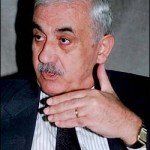
I met a lot of other Arab terrorists over the years, some of them in somewhat humorous ways. George Habash and I had dinner together one evening in Damascus. George was the head of the Popular Front for the Liberation of Palestine (PFLP), but as tough as he was, he didn’t have terrorist credentials that one would have thought a terrorist should have. George was a pediatrician in his earlier life, an Orthodox Christian, and, as I learned over dinner, a very distinguished and intelligent person.
Ahmed Jabril, the head of the breakaway group, Popular Front for the Liberation of Palestine, General Command, whom I had met at the Libyan National Day celebration in Benghazi, Libya, once had a relative in the United States to call and ask me if I would represent Ahmed against the Washington Post, which had called him a terrorist. Usually I would tell such a potential litigant that truth is a defense, but in Ahmed’s case, I told his relative that bringing such a lawsuit would require his presence in the United States for the proceedings. He lost interest in pursuing litigation.
If you remember the infamous terrorist Abu Nidal, you will appreciate what happened to an innocent Palestinian who was a college professor in Norway. Somehow the Washington Post printed the professor’s photo identifying him as Abu Nidal, the most feared and cruel Palestinian terrorist on the planet during the years he was active.
The professor himself called me from Norway and asked me to represent him in a lawsuit against the Post for causing him unending misery because of the mis-identification. He told me that any time he went through an airport anywhere in Europe, it would take him hours to get cleared, as well as a major effort to prove that he wasn’t Abu Nidal. I could sympathize with him, but I saw so many difficulties with such a lawsuit that I begged off.
I was hired in 1986 by an Iraqi-American car dealer in California to try to get an exit visa from Iraq for a young Iraqi woman who had agreed to marry him. He paid me a handsome fee, so I was happy to make the effort. I called an Iraqi friend who worked at the United Nations and asked him to help. He agreed, sending off a message to the Saddam Hussein government to make the request.
As I was preparing for my trip, with just a couple of days before I was scheduled to leave for Baghdad, my friend called and told me that my request had been granted. I called my client to tell him the news, but I also told him that I probably should go to Baghdad anyway to make sure things were smoothed over. He agreed, and I went.
My first meeting was with Tareq Aziz, then the Foreign Minister of Iraq. Tareq is an Assyrian and was the only Christian in the Hussein government. He also spoke English quite well, which put him in the position of being an international spokesman for the Saddam Hussein government. (Aside from the official Hussein government spokesman whom everyone called, “Baghdad Bob,” who once denied on television the presence of American tanks in Baghdad—while at the same time, viewers could easily see the U.S. tanks over his right shoulder.)

Aziz mentioned to me that Arafat was in town, that he had a PLO headquarters in Baghdad. So we called him, and along with my traveling companion, Harold Samhat, from Detroit, were invited to dinner with Arafat that very evening. When I arrived at his headquarters, I found a small group of people dining with Yasir, including Abu Jihad (who was assassinated by the Israelis in Tunis a couple of months after that dinner), his wife, Umm Jihad, and Raymonda Tawil, Arafat’s future mother-in-law. We had finished dinner when Raymonda approached me and said there was someone in Baghdad who wanted to meet me. When I asked who the mystery man was, she told me it was Abul Abbas, probably the world’s most notorious Palestinian during that year. Abul Abbas was accused of being the architect of the hijacking of the Achille Lauro, an Italian cruise ship, and the killing of Leon Klinghoffer, the elderly Jewish man in a wheelchair who was murdered by one of the hijackers and thrown overboard.
Harold and I went to the home of Abul Abbas the next evening for dinner. We met his wife, who was Lebanese, as well as his children, and were seated for an excellent dinner.
After dinner I raised the question of the Achille Lauro with Abul Abas. Over the next hour and a half or so, he related the most fascinating story I’d heard in a long time. He claimed that the four Palestinians who had hijacked the Achille Lauro had been his men at an earlier time, and he said that he had actually trained them at the time to hijack a cruise ship. But he also claimed that was long ago and that he had nothing to do with the Achille Lauro.
He was, he said, returning through Cairo from Baghdad to Tunis, Arafat’s main headquarters. He was contacted in the Cairo Airport by someone in the PLO telling him about the hijacking, and asking him to do something about it. At that point there was a standoff of sorts. The hijackers had agreed to leave the ship in return for safe passage, so Abul Abbas and the four hijackers were put on an Egyptian passenger jet. But President Reagan ordered the U.S. military to force the passenger plane to land at the Sigonella NATO air station on Italian soil. There the Italian military took control of the plane containing both the hijackers and Abul Abbas.
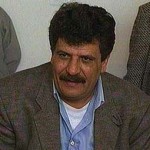
According to Abul Abbas, a U.S. colonel first came up the stairs of the passenger jet and began shouting in a threatening way at Abul Abbas. Abbas said that at the time he had no weapons and was dressed in a suit and tie, but he told the U.S. colonel that if he continued shouting he would throw a hand grenade at him. The colonel retreated back down the stairway.
Next, an Italian officer came aboard the jet, whereupon Abul Abbas told him that, “we are in the same position.” Asked what he meant by that, Abass said, “we are both required to follow American orders.” The Italian Colonel was enraged by the accusation.
With that doubt set into the officer’s mind, Abbas spoke with the PLO representative to Italy and asked for instructions from Arafat. The PLO official eventually told Abbas that, according to Arafat, he should give up the four hijackers on condition that he, Abbas, be allowed to leave freely.
Abbas told me that when Arafat, his boss, gave an order, he followed it. This was interesting information for me, as Arafat had loudly proclaimed that Abbas was a free agent and that his actions had nothing to do with Arafat. The PLO ambassador to Italy arranged for a flight out Italy to Czechoslovakia, at that time still a satellite of the Soviet Bloc, and from there back to Baghdad.
Abul Abbas was captured in Baghdad in 2003 by U.S. forces after the invasion of Iraq, and died in American custody in 2004.
A little known side story about Arafat and Syrian President Hafez Al Asad took place following the 1973 Arab-Israeli war. After the War ended in 1973, Arafat flew to Damascus to meet with Asad, primarily to complain to him that he didn’t give the Palestinians enough help during the war.
“What do you mean we didn’t help,” Asad said angrily. “We lost over 100 fighter planes and that many pilots trying to help. What more could we do?” But Arafat continued to complain. Hafez Al Asad had enough of Arafat, and what he got for his complaints was a Syrian-backed uprising in the ranks of the PLO led by a pro-Asad Palestinian, Abu Musa. Arafat finally put down the uprising and retained his leadership, but at great cost to him.
Asad wasn’t done with him, however. As much as Arafat and the PLO denied doing anything to Klinghoffer, saying he accidentally fell overboard, he was in for more trouble caused by the Syrian President. Klinghoffer’s body washed ashore on a beach at Tartous, Syria. Learning that there was a visible bullet wound that was the cause of his death, Asad turned the body over to the U.S. authorities, putting the lie to Arafat’s denials.
[1] Wikipedia entries in this article were accessed on February 27, 2012. Since Wikipedia can be edited by anyone at any time, and since Israel partisans have been known to exploit this process, Wikipedia articles can at times be unreliable and should be used with coonsiderable caution. Some websites have banned their use for this reason.
Source: Council for the National Interest
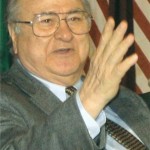 JAMES ABOUREZK is a board member of the Council for the National Interest (CNI) and is a contributor to CounterPunch and the Washington Report on Middle East Affairs. He is the author of numerous articles and books, including Advise & Dissent: Memoirs of South Dakota and the U.S. Senate.
JAMES ABOUREZK is a board member of the Council for the National Interest (CNI) and is a contributor to CounterPunch and the Washington Report on Middle East Affairs. He is the author of numerous articles and books, including Advise & Dissent: Memoirs of South Dakota and the U.S. Senate.
His e mail address is: georgepatton45@gmail.com
ATTENTION READERS
We See The World From All Sides and Want YOU To Be Fully InformedIn fact, intentional disinformation is a disgraceful scourge in media today. So to assuage any possible errant incorrect information posted herein, we strongly encourage you to seek corroboration from other non-VT sources before forming an educated opinion.
About VT - Policies & Disclosures - Comment Policy

